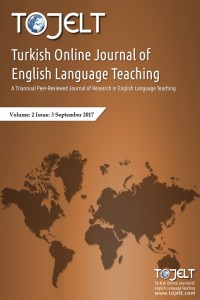Research Article
Year 2017,
Volume: 2 Issue: 3, 113 - 119, 30.09.2017
Abstract
Lomb Kato and
Steven Kaufman have each acquired at least 15 languages as adults, many without
living the country where the language is spoken. Their observations about
language acquisition are in close agreement with the claims of current second
language acquisition theory.
Keywords
References
- Alkire, S. (2005). Kato Lomb’s strategies for language learning and SLA. International Journal of Foreign Language Teaching, 1, 17-26.
- Csikszentmihalyi, M. (1990). Flow: The psychology of optimal experience. New York: Harper Perennial.
- Dupuy, B. (2000). Narrow listening: An alternative way to develop and enhance listening comprehension in students of French as a foreign language. System, 27, 351-361
- Kaufman, S. (2003). The linguist: A personal guide to language learning. Steve Kaufman.
- Krashen, S. (1981). Second language acquisition and second language learning. London: Pergamon. Retrieved Dec. 1, 2017 from www.sdkrashen.com.
- Krashen, S. (1982). Principles and practice in second language acquisition. New York: Pergamon Press. Retrieved Jan. 11, 2018 from www.sdkrashen.com.
- Krashen, S. (1994). The pleasure hypothesis. In J. Alatis (Ed.) Georgetown University Round Table on Languages and Linguistics. Washington, DC: Georgetown University Press. pp. 299-322.
- Krashen, S. (2003). Explorations in language acquisition and use: The Taipei lectures. Portsmouth, NH: Heinemann.
- Krashen, S. (2011). The compelling (not just interesting) input hypothesis. The English Connection (KOTESOL). 15, 1
- Krashen, S. (2012). Developing academic proficiency: Some hypotheses. International Journal of Foreign Language Teaching, 2, 8-15.
- Krashen, S. (2014a). Comprehensible input-based methods vs. traditional methods. http://skrashen.blogspot.com/2014/08/comprensible-input-based-methods-vs.html.
- Krashen, S. (2014b.) Case histories and the comprehension hypothesis. TESOL International Journal, 9, 70-91.
- Krashen, S. & Kiss, N. (1996). Notes on a polyglot: Kato Lomb. System, 24, 207-210.
- Lao, C. & Krashen, S. (2014). Language acquisition without speaking and without study. Journal of Bilingual Education Research and Instruction 16, å215-221.
- Lomb, K. (2016). With languages in mind. Berkeley: TESL-IJ Publications.
- Mason, B., & Krashen, S. (2017). Self-selected reading and TOEIC performance: Evidence from case histories. Shitennoji University Bulletin, 63, 469-475.
- Rodrigo, V. & Krashen, S. (1996). La audicion enfocada en el aula y fuera de ella. GRETA 4(2): 71-73.
- Swanborn, M. and de Glopper, (1999). Incidental word learning while reading: A meta-analysis. Review of Educational Research 69, 261-285.
- Twadell, F. (1973). Vocabulary expansion in the TESOL classroom. TESOL Quarterly, 7, 61-78.
- Truscott, J. (1999). What’s wrong with oral grammar correction. Canadian Modern Language Review, 55, 457-467.
- Truscott, J. (2016). The effectiveness of error correction: Why do meta-analytic reviews produce such different results? In Leung, Yiu-nam (Ed.), Epoch Making in English Language Teaching and Learning, Twenty-fifth International Symposium on English Teaching, English Teachers' Association, Republic of China. pp. 126-141.
Year 2017,
Volume: 2 Issue: 3, 113 - 119, 30.09.2017
Abstract
References
- Alkire, S. (2005). Kato Lomb’s strategies for language learning and SLA. International Journal of Foreign Language Teaching, 1, 17-26.
- Csikszentmihalyi, M. (1990). Flow: The psychology of optimal experience. New York: Harper Perennial.
- Dupuy, B. (2000). Narrow listening: An alternative way to develop and enhance listening comprehension in students of French as a foreign language. System, 27, 351-361
- Kaufman, S. (2003). The linguist: A personal guide to language learning. Steve Kaufman.
- Krashen, S. (1981). Second language acquisition and second language learning. London: Pergamon. Retrieved Dec. 1, 2017 from www.sdkrashen.com.
- Krashen, S. (1982). Principles and practice in second language acquisition. New York: Pergamon Press. Retrieved Jan. 11, 2018 from www.sdkrashen.com.
- Krashen, S. (1994). The pleasure hypothesis. In J. Alatis (Ed.) Georgetown University Round Table on Languages and Linguistics. Washington, DC: Georgetown University Press. pp. 299-322.
- Krashen, S. (2003). Explorations in language acquisition and use: The Taipei lectures. Portsmouth, NH: Heinemann.
- Krashen, S. (2011). The compelling (not just interesting) input hypothesis. The English Connection (KOTESOL). 15, 1
- Krashen, S. (2012). Developing academic proficiency: Some hypotheses. International Journal of Foreign Language Teaching, 2, 8-15.
- Krashen, S. (2014a). Comprehensible input-based methods vs. traditional methods. http://skrashen.blogspot.com/2014/08/comprensible-input-based-methods-vs.html.
- Krashen, S. (2014b.) Case histories and the comprehension hypothesis. TESOL International Journal, 9, 70-91.
- Krashen, S. & Kiss, N. (1996). Notes on a polyglot: Kato Lomb. System, 24, 207-210.
- Lao, C. & Krashen, S. (2014). Language acquisition without speaking and without study. Journal of Bilingual Education Research and Instruction 16, å215-221.
- Lomb, K. (2016). With languages in mind. Berkeley: TESL-IJ Publications.
- Mason, B., & Krashen, S. (2017). Self-selected reading and TOEIC performance: Evidence from case histories. Shitennoji University Bulletin, 63, 469-475.
- Rodrigo, V. & Krashen, S. (1996). La audicion enfocada en el aula y fuera de ella. GRETA 4(2): 71-73.
- Swanborn, M. and de Glopper, (1999). Incidental word learning while reading: A meta-analysis. Review of Educational Research 69, 261-285.
- Twadell, F. (1973). Vocabulary expansion in the TESOL classroom. TESOL Quarterly, 7, 61-78.
- Truscott, J. (1999). What’s wrong with oral grammar correction. Canadian Modern Language Review, 55, 457-467.
- Truscott, J. (2016). The effectiveness of error correction: Why do meta-analytic reviews produce such different results? In Leung, Yiu-nam (Ed.), Epoch Making in English Language Teaching and Learning, Twenty-fifth International Symposium on English Teaching, English Teachers' Association, Republic of China. pp. 126-141.
There are 21 citations in total.
Details
| Journal Section | Articles |
|---|---|
| Authors | |
| Publication Date | September 30, 2017 |
| Published in Issue | Year 2017 Volume: 2 Issue: 3 |


